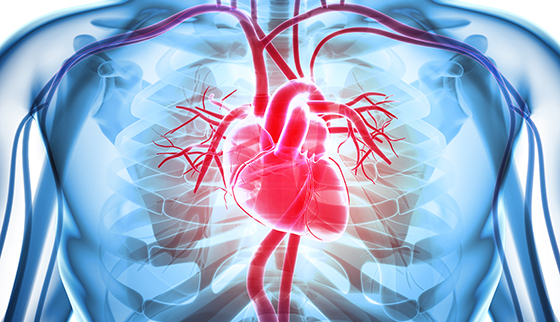The heart basically functions as a pump. It pumps normally at a rate of 60 to 100 beats per minute, and this can increase to 160-180 beats per minute during vigorous exercise. The heart is able to pump because it is made of muscles which are able to contract, just like the muscles in your arm. However, heart muscles are quite special, it that it does not fatigue; as you can imagine, the heart muscle does not stop working, or take a break (you would be in trouble if it did!)
To continue contracting, just like any other machine, it needs to be provided with a constant source of energy. This is achieved through a network of blood vessels which supply the heart with blood rich in oxygen and glucose, which is like fuel for living cells.
Cardiovascular disease, in layman’s terms, usually refers to Coronary Artery Disease, which is a disease where the Coronary Arteries to the heart get narrowed and start blocking off. Strictly speaking, when you say Cardiovascular disease, it refers to any of the myriad conditions that can affect the heart or the blood vessels of the body, but for this discussion we will limit it to disease of the blood vessels of the heart.
The blood vessels of the heart can get damaged and occluded by several factors, the common ones being cigarette smoking, diabetes mellitus, high blood pressure, high cholesterol, chronic stress and unfortunately, bad genes. These factors work over time to narrow down one or more of the coronary arteries by building up plaque within the artery (consider it a collection of a mixture of cholesterol). At a critical juncture, the artery gets narrowed so that it compromises the blood supply to a particular part of the heart. As you can imagine, as the vessel narrows, less blood is able to flow through the narrowed segment. It is like if you pinch your garden hose while watering your plants, less water can flow through the hose. If you pinch it hard enough, no water can flow through it.
In a similar way, the narrowed artery can get say, 90% narrowed, or even completely blocked. This gives rise to two clinical scenarios. One is where the vessel is badly narrowed (say 90%), where the patient then has greatly diminished blood supply to the heart muscle. The person may not have chest pain or shortness of breath at rest (where the heart is beating relatively slowly, but he would get these symptoms the moment he exerts himself, because when you exert yourself, the body needs more blood supply, and the heart has to speed up and pump harder. This is called effort angina or chest pain on exertion. The second scenario is a more serious condition where the coronary artery suddenly blocks off completely and no blood can flow through the occlusion at all. This is commonly called a heart attack, and it can potentially stop the heart, killing the patient.
The symptoms of angina and a heart attack can be quite variable, but normally would include chest pain and shortness of breath. As alluded to earlier, angina usually is brought on by exertion. The pain is classically described as a heavy or gripping sensation over the chest, and can radiate to the left shoulder and arm, or up to the neck. In severe cases, it can be accompanied by shortness of breath and occasionally, undue sweating.
In angina (ie: narrowed artery) the symptoms are ameliorated by stopping the physical activity that it on. In a heart attack, these symptoms are more pronounced and unrelenting. The artery is completely blocked, therefore the chest pain is persistent. It can be accompanied by profuse sweating, nausea and even vomiting. In severe cases, the patient may even pass out due to the heart transiently stopping. As you can imagine, this is a very dangerous situation and warrants immediate/emergency treatment.

Coronary Artery Disease as per above is highly treatable. Bad narrowing in the coronary arteries can be corrected by putting a stent (a kind of tube made of fine wires) across the narrowing and opening up the occlusion using specialised balloons. This fixes the immediate problem, and improves blood flow down the artery. Of course, it is only part of the treatment. The artery may have other areas affected by the conditions that resulted in the narrowing of the artery and it needs to be addressed. This requires treatment to control blood pressure, diabetes and high cholesterol. This is achieved by taking medication and lifestyle changes. Smoking cessation is very important in heart patients as well.
The risk for heart disease differ between the sexes. Men are 10 times more likely to develop heart disease compared to women, well this is true for younger women. After menopause, the risk for heart disease becomes even between men and women.
In certain patients with very bad blockages in the arteries or blockages which are deemed high risk for angioplasty, your doctor may suggest Bypass Surgery. This involves taking a vein from your leg and using it to “bypass” the blockages by linking the coronary arteries to the aorta (the main vessel from the heart).
Now we continue from paragraph 6:
Heart disease in the sexes also differ in terms of susceptibility to the risk factors. Women are more likely get heart disease if they smoke heavily, more so than men. Older women also tend to take calcium supplements, which actually increases your risk for calcium deposits in the arteries!
In terms of advice for the young and old, I feel the advice is fairly similar. Good healthy eating habits and regular exercise are important. Healthy eating basically is eating in moderation. Don’t over-eat! Cut down on saturated fats (fatty meats, innards and oils), processed meats (sausages, spam) and fried foods. Also reduce your carbohydrate intake. We should include more fruits and vegetables in our diet, and cut down on snacks in between meals. Aim to keep your BMI below 25. Exercise should be tailored to the person’s age. Younger people should aim for aerobic activity that doubles the resting heart rate to about 130-140/min for 20 minutes 5 times a week. A slow jog or playing football or racket sports should easily achieve this. As we get older, vigorous activity may result in injuries, so in the over-50’s I think brisk walking for 30 minutes is good enough.
It is never too early or late to institute these lifestyle changes so that your heart remains healthy.
Article by Dr. Edward Mah Mun Jeun,
Visiting Consultant Cardiologist.

